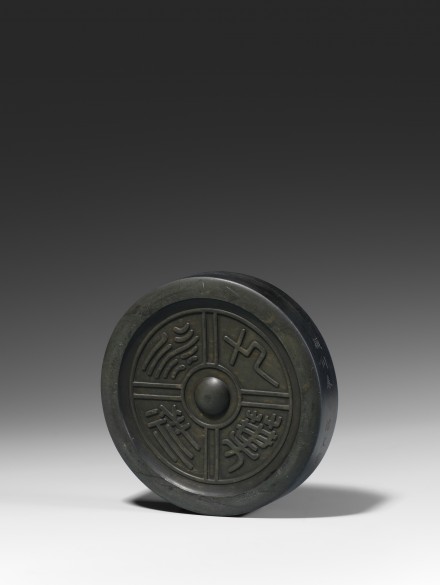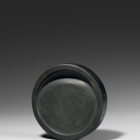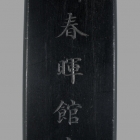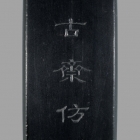J.J. Lally & Co., Oriental Art / New York City, New York
MenuPast Exhibition
ELEGANTLY MADE: Art for the Chinese Literati
March 13-27, 2020

25.
A SHE INKSTONE IN THE FORM OF A HAN TILE-END
18th – 19th Century
of thick cylindrical section, carved from black she stone flecked with pale greenish natural markings, decorated on one side in the style of pottery tiles on the eaves of Han dynasty imperial palaces with four large seal script characters within fan shape reserves radiating from a central boss, all in relief filling a recessed medallion within a wide raised rim, the reverse with a slightly concave grinding surface and adjacent crescent shape water well recessed with a wide raised rim, the narrow vertical sides incised with two inscriptions in kaishu, the heavy, dense stone smoothly polished all over.
Diameter 5 7⁄8 inches (14.9 cm)
Provenance
A Japanese private collection, 2006
Brian Harkins, London, January 2007
Shuisongshi Shanfang Collection
The four large seal script characters may be read as: 七葉永祥 (qi ye yong xiang, Eternal Good Fortune for Seven Generations). The kaishu inscriptions on the sides may be read as: 鑑古齋仿製 (Jiangu zhai fangzhi, made in emulation [of a Han eaves-tile] at the Studio of Appreciation of Antiquity) and 穎川春暉館文寶 (Yingchuan Chunhui guan wenbao, Cultural Treasure of Springtime Sun Hall in Yingchuan).
Jiangu zhai, the manufactory of the Wang Jinsheng family (汪近聖, active early 18th century) in Huizhou, Anhui province where ink and instones were produced, is known to have made ink for the imperial palace during the Qing dynasty. She stone is a variety of slate found in She county, Anhui province. It is a favorite material for inkstones and has been in use since the Tang dynasty.
A very similar she inkstone with the same two kaishu inscriptions on the narrow sides but decorated with four different large seal characters is illustrated in the catalogue of an exhibition at the National History Museum in Taipei, Shuang qing cang yan (The Fine Chinese Inkstone: Collection of Steven Hung and Lindy Chern), Taipei, 2001, pp. 264-265.
Two Han pottery eaves-tiles cut and polished for use as inkstones formerly in the Fujita Museum in Osaka are published in Important Chinese Art from the Fujita Museum, Christie’s New York, 15 March 2017, lot 519. Two other Han pottery eaves-tile inkstones are illustrated by Wei and Yang (eds.), Zhongguo yantai tulu (Illustrated Catalogue of Chinese Inkstones), Ürümiqi, 2002, pp. 112 and 140.
十八 – 十九世紀 歙石仿漢「七葉永祥」瓦當硯 徑 14.9 厘米
「鑑古齋仿製」「穎川春暉館文寶」款
來源 日本私人收藏,2006
倫敦Brian Harkins 舊藏,2007 年一月
水松石山房藏
Additional Images (Touch to enlarge)
25.
A SHE INKSTONE IN THE FORM OF A HAN TILE-END
18th – 19th Century
Diameter 5 7⁄8 inches (14.9 cm)


